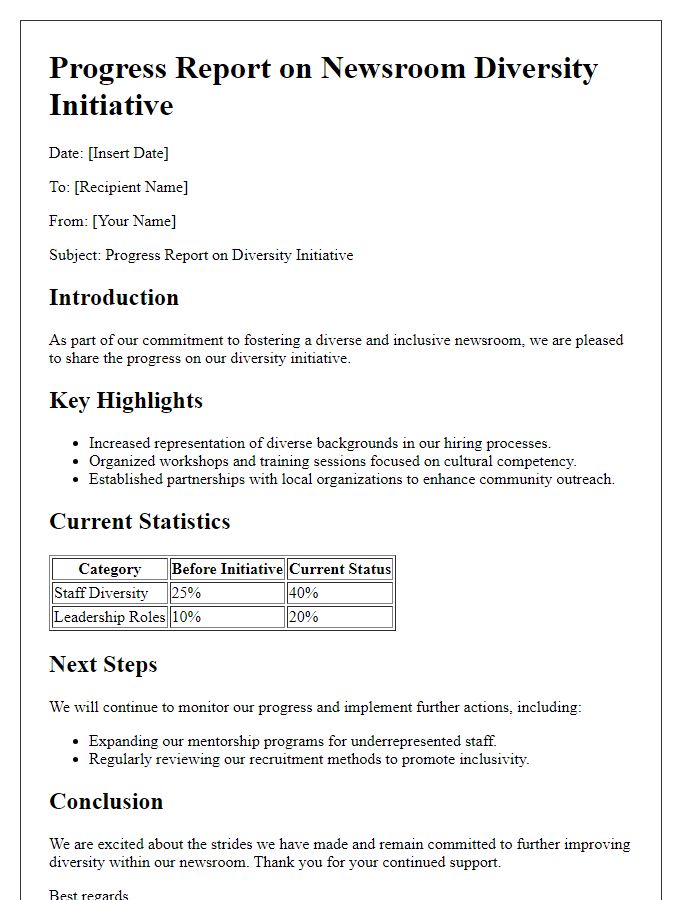Are you passionate about promoting diversity in journalism? Our newsroom is excited to explore innovative proposals aimed at fostering inclusivity and representation in our reporting and hiring practices. We believe that a diverse newsroom not only reflects the communities we serve but also enhances the quality of our storytelling. Join us in this important conversation and discover how you can contribute to our diversity initiative by reading more!

Purpose and Goals of the Initiative
The newsroom diversity initiative aims to foster an inclusive media environment that reflects the diverse population it serves. This initiative intends to address underrepresentation within journalistic teams, particularly for marginalized groups based on race, ethnicity, gender, and disability. By implementing targeted recruitment strategies, such as partnerships with historically black colleges and universities (HBCUs) and community organizations, the initiative seeks to increase the hiring of diverse talent in key editorial positions. Workshops and training sessions will emphasize cultural competence and equitable storytelling practices, ensuring that diverse perspectives are integrated into reporting. Additionally, the initiative strives to create a mentorship program that connects established journalists with emerging talents from varied backgrounds, promoting career advancement and retention rates within the newsroom. Successful execution of this initiative could lead to more accurate reporting, improve audience engagement, and enhance the overall credibility of the media organization in representing its community.
Current Diversity Assessment
A current diversity assessment highlights various demographic factors impacting organizational representation in newsrooms across the United States. The American Society of News Editors reportedly found that in 2022, only 22% of newsroom employees identified as people of color, with underrepresentation of minorities such as African Americans, Latinos, and Asian Americans. Gender representation is also concerning, as women account for approximately 40% of newsroom staff according to the Pew Research Center. Location significantly influences diversity, with urban areas frequently showcasing higher percentages of diverse talent due to more inclusive community structures. Furthermore, media organizations must recognize intersectionality (the overlapping of social identities) to better understand the unique challenges faced by individuals with multiple marginalized identities within the newsroom environment. A comprehensive diversity assessment must include these metrics to identify gaps, set benchmarks, and develop actionable strategies for fostering inclusivity in news production.
Proposed Strategies and Actions
Diversity initiatives in newsroom environments aim to foster inclusive representation across various demographics, focusing on race, gender, age, and socio-economic status in media organizations. Research by the American Press Institute indicates that diverse newsrooms can enhance storytelling and engage broader audiences, resulting in higher viewership ratings. Proposed strategies include implementing targeted recruitment campaigns at historically black colleges and universities (HBCUs) and partnering with organizations like the National Association of Black Journalists to facilitate mentorship opportunities. Additionally, conducting regular diversity training workshops can help staff recognize biases, ultimately improving overall newsroom culture. Commitment to tracking diversity metrics through annual audits will ensure accountability and guide future actions, influencing editorial choices and fostering community trust in media.
Measurement and Evaluation Metrics
A comprehensive diversity initiative proposal in newsrooms must include robust measurement and evaluation metrics to assess effectiveness. Key performance indicators (KPIs) should encompass race, gender, and ethnicity of staff compared to community demographics, aiming for alignment with local population statistics. Surveys conducted quarterly can gauge employee perceptions of inclusivity, measuring factors like sense of belonging and accessibility. Recruitment and retention rates of diverse candidates should be analyzed yearly, with a specific focus on the pipeline processes from internships (often serving as entry points) to permanent employment. Audience engagement metrics, including feedback from community members and representation in stories, are crucial for evaluating responsiveness to diverse perspectives. Regular reporting of findings, ideally every six months, will ensure accountability and transparency, helping to refine ongoing diversity strategies.
Timeline and Milestones
In the context of newsroom diversity initiatives, establishing a timeline and milestones is crucial for measuring progress and accountability. For instance, a comprehensive timeline might span from January 2024 to December 2025, with significant milestones such as the formation of a diversity committee by March 2024, initial diversity and inclusion training sessions completed by June 2024, and the publication of a diversity assessment report by September 2024. Additionally, outreach partnerships with local community organizations could be formed by December 2024 to enhance recruitment efforts for underrepresented voices. Progress reviews can be scheduled quarterly, allowing for adjustments to be made as needed throughout 2025, ultimately culminating in an annual diversity impact report by December 2025 evaluating the effectiveness of the initiatives implemented.
Letter Template For Newsroom Diversity Initiative Proposals Samples
Letter template of newsroom diversity initiative collaboration invitation

Letter template of newsroom diversity initiative training program details

Letter template of newsroom diversity initiative community engagement plan











Comments